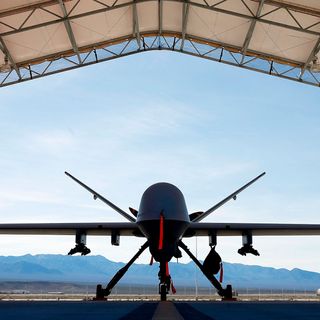Australian leaders don't often talk about nuclear deterrence.
But in a pair of coordinated statements in Parliament last week on Pine Gap and other joint defence facilities, Defence Minister Christopher Pyne and his shadow, Richard Marles, offered a rare glimpse into the sophisticated strategic capabilities that underwrite the United States-Australia alliance.
Their endorsements of Australia's active role in contributing to US conventional and nuclear deterrence in the Indo-Pacific was characteristic of the bipartisanship that previous leaders have shown on this critical strategic policy issue. By speaking frankly about Australia's own national interests in the joint facilities, Mr Pyne and Mr Marles did an excellent job of putting this misunderstood topic back on the public agenda.
Trump-Kim talks set the scene
The timing is right. With a mercurial Donald Trump about to touchdown in Asia for a fresh round of nuclear talks with North Korean dictator Kim Jong-un, many Australians are rightly anxious about the role of nuclear weapons in our region.
It may be an uncomfortable conversation, but Australians need to become more familiar with the strategic logic for cooperation in deterring major power war.
For those, like the International Campaign to Abolish Nuclear Weapons (ICAN), who see these weapons as illegitimate and their overlords unreliable, it is tempting to simply argue that Australia should have no role in America's nuclear enterprise. This would be a grave mistake.
As the Indo-Pacific strategic environment deteriorates at an alarming pace, with multiple nuclear powers modernising and strengthening their arsenals, it is imperative that liberal democracies retain the capacity for effective deterrence. Part of ensuring this is an informed public.
It may be an uncomfortable conversation, but Australians need to become more familiar with the strategic logic for cooperation in deterring major power war.
Australia's track record
Australia is a quiet achiever in the deterrence business. Behind the political spotlight on our contributions to the Middle East and the public writhing over our presence in the Pacific and South China Sea, Canberra works discreetly with Washington on strategic intelligence and nuclear deterrence.
This, as Minister Pyne made clear, has involved monitoring foreign weapons development, facilitating communication with military forces, and verifying the use or testing of weapons of mass destruction. It is among the alliance's most critical functions. Australia's joint defence facilities have accordingly become an integrated part of the system of credible deterrence upon which stability in the Indo-Pacific depends.
Mapping the Third Offset: Australia, the United States and future war in the Indo-Pacific

This doesn't mean Canberra lacks political control. On the contrary, Mr Pyne and Mr Marles both emphasised the fact that US and Australian teams working at our joint facilities do so with the "full knowledge and concurrence" of the Commonwealth government.
The value of this deep trust and cooperation is hard to overstate. Australia's active support of US deterrence affords us protection under Washington's extended nuclear umbrella, and provides us access to cutting-edge technology, advanced defence capabilities and exquisite intelligence products that we wouldn't otherwise get.
Our joint facilities also enable Canberra to play a pivotal role in maintaining regional order. The most well-known facility, the Pine Gap ground station, provides reliable early warning of ballistic missile launches, information on weapons testing, and intelligence on international developments that could threaten stability and economic wellbeing in the Indo-Pacific and beyond.
Australia-US alliance
Less well-known is the Geological and Geophysical Research Station in Alice Springs, which is jointly run by Geoscience Australia and the US Air Force. According to Mr Pyne, this facility detected and geo-located North Korea's sixth nuclear test in September 2017, highlighting its key role in monitoring state compliance with the Comprehensive Test Ban Treaty that prohibits explosive nuclear tests.
Elsewhere, the Harold E Holt Naval Communication Station in Exmouth — once jointly run, now operated solely by Australia — is charged with providing communications to allied naval ships and submarines. This, Mr Pyne said, includes communications for the nuclear deterrence capabilities onboard America's strategic submarines in the Indo-Pacific, a critical foundation for US operations and a favourable balance of forces in the region.
All this is important to have in the public debate considering how infrequently Australians think about nuclear deterrence and our national interests in the same sentence.
There is, it appears, a growing divide between anti-nuclear groups — like ICAN — that are lobbying for a world without nuclear weapons, and governments like Australia's and those of our close security partners that are struggling with the requirements of deterrence in a region that's experiencing aggressive technological change and power transition.
Opinion is divided
Meanwhile the public is left in the middle. In polling conducted by the United States Studies Centre in conjunction with YouGov in 2018, Australians were divided 39 to 38 per cent over whether the US should modernise its nuclear capabilities in response to changes in Chinese and Russian arsenals. A further 23 per cent were undecided.
These figures point to a lack of information or consensus about the key policy direction of America's 2018 Nuclear Posture Review, which Australia's joint facilities would likely have a role in supporting. Only our leaders can address this perception gap.
It is a stark picture. There are more nuclear-armed powers in the Indo-Pacific than any other region and all are modernising or growing their weapons stockpiles.
Highlighting Australia's role in nuclear deterrence and arms control is part of the equation. The other is sketching out the threat environment that necessitates our ongoing support for deterrence.
It is a stark picture. There are more nuclear-armed powers in the Indo-Pacific than any other region and all are modernising or growing their weapons stockpiles.
China is investing heavily in long-range missile systems and is moving towards deploying nuclear weapons at sea. India and Pakistan are adding new weapons to their arsenals, with both on tenterhooks after a suicide bombing in Kashmir killed 44 Indian policemen this month. And North Korea, now a fully-fledged nuclear power, is continuing to improve its weapons despite Trump's assertions to the contrary.
New technology
This situation is made even more dangerous by the impending arrival of new technologies.
For instance, if China's development of hypersonic missiles is successful, Beijing will possess a long-range weapon that is fast enough to overwhelm any existing defences. In response, the Trump administration is already considering "active missile defence" options to attack these weapons at their launch sites in the event of conflict, raising the spectre of escalation.
As our joint facilities would likely be critical in providing early warning in this scenario, such frightening developments concern us directly. In an era of rising strategic competition, Canberra is assuming a greater leadership role in building a stable and prosperous Indo-Pacific.
While our efforts in the Pacific have garnered most attention, our contributions to US nuclear deterrence are just as significant — and may well increase in line with intensifying regional challenges. This is not a pleasant topic. But it's time we put informed nuclear debate back on the public agenda.







